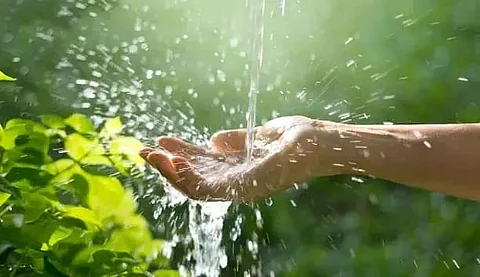
- Home
- Live Blog
- Breaking News
- Top Headlines
- Cities
- NE News
- Sentinel Media
- Sports
- Education
- Jobs

The National Water Mission (NWM)'s campaign 'Catch the rain: Where it falls, when it falls' has become more relevant for residents in Guwahati grappling with the problem of water shortage. Awareness drive on rainwater harvesting turning into a people's movement beyond routine and official campaign under the NWM mission is crucial to achieve the desired result. Harvested rainwater can be used for household chores like washing clothes, cleaning, watering household plants, washing utensils and in toilets. It will reduce the household water bill paid by those residents who purchase water supplied from private water tankers for meet daily household requirement. Rainwater harvesting solutions are equally important for even those households, multistoried apartments which are dependent on borewell for underground water. Apart from cutting down their electricity bill it will also help conservation of underground water during rainy season. Besides, reduced use of submersible pumps will help maximizing its lifespan. One of the key objectives of the NWM campaign for rainwater harvesting is to ensure that zero or less water flows out of a compound so that it helps in improving soil moisture and result in raising of the groundwater level. For a city like Guwahati, this has an added advantage of optimizing rainwater holding capacities of city drain network to prevent waterlogging on streets and bylanes. Copious quantity of rainwater flow out to streets as surface runoff from compounds of residential, government office and commercial establishments. Non-perforated concrete slab cover on entire compound poses a barrier in percolation of rainwater to underground aquifer but unfortunately for most residential building, commercial complexes have no provision for percolation of rainwater. The Guwahati Building Construction Byelaws stipulates that every building shall provide one or more rainwater harvesting structures to collect the roof top run-off and provide percolation pits filled with pebbles, brick jelly or river sand and covered with perforated concrete slabs. The building byelaws also provide that in addition to mandatory green space in each compound, all paved areas shall be done in a type of perforated paving (in- situ or readymade) where 10%-15% of the area is covered by grass. It makes connecting the terrace to a sump or a well through a filtering tank with PVC pipe and open ground percolation by removing a portion of topsoil and replaced with river sand and discharging roof top water to a well after filtration optional provisions for obtaining building permission, but benefits are huge if adopted. With no visible enforcement of mandatory rooftop water for compounds with 100 sq meters and above in the city, rainwater harvesting as an adopted practice is not visible in this city burdened with rapid expansion and rising population pressure. Delay in commissioning of piped water supply projects in the city has led to depletion of underground water table and in several localities, wells, hand pumps have gone dry compelling residents in those areas to incur heavy expenses for digging borewell and using costly submersible pumps. Those who cannot afford such heavy expenditure are depending on daily purchase of water supplied by private tankers. Apart from pre-monsoon rains during April-May, the city receives huge rainfall during four monsoon months of June, July, August and September and harvesting the raindrops in these six months can drastically cut down household expenses besides contributing to water and electricity conservation. Therefore, rainwater harvesting even after all water supply projects are commissioned in the city can significantly reduce demand for electricity and under groundwater at least for six months in a year, provided the city residents are made aware of these benefits for individual household and overall environment of the entire city. Apart from providing silt traps in the drain, bringing rainwater from eroded patches of hills and improved drains, reducing runoff of surface water to the streets can be an effective solution to reduce rainwater accumulation on city streets. Newly-elected body of Guwahati Municipal Corporation can play a crucial role in giving boost to the 'Catch the Rain' campaign with ward councilors undertaking door-to-door awareness drive with the same passion as they had approached residents in their respective ward seeking votes. Involving school students, parents, teachers, local clubs, chapters of senior citizens, women groups, and all NGOs in each locality of a ward can embolden the campaign with fresh momentum. Organizing competition for ward residents on designing cost-effective rainwater harvesting models can also go a long way in spotting innovative designs for adoption. The GMC, organizing demonstration of percolation pits/recharging techniques in collaboration with builders' association, architects, Central Ground Water Board authorities can be expected to take the campaign among builders and those planning construction new individual house or existing house owners planning renovation. Making rainwater harvesting structures integral components of building design including retrofittingsolutions for an environment-friendly house in the dream city is the need of the hour.